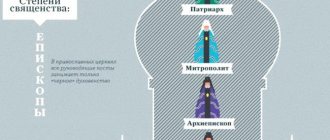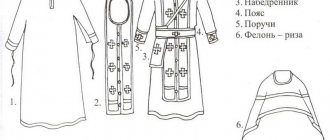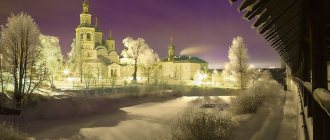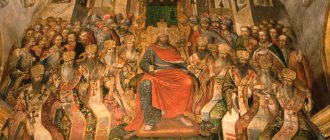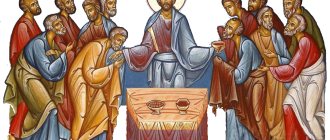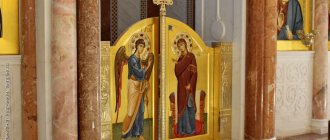Faces of Holiness
The following faces of holiness are accepted in the Orthodox Church.
Apostles (ap.) are the closest disciples of Jesus Christ, whom He sent to preach during His earthly life; and after the descent of the Holy Spirit on them, they preached the Christian faith throughout all countries. There were first twelve of them, and then seventy more.
- Two of the apostles, Peter and Paul, are called the First Supreme , since they worked more than others in preaching the faith of Christ.
- The four Apostles: Matthew, Mark, Luke and John the Theologian, who wrote the Gospel, are called Evangelists .
The unmercenaries (bessr.) served as free healers of illnesses for their neighbors, that is, they healed illnesses, both physical and mental, without any payment, such as: Cosmas and Damian, the great martyr and healer Panteleimon and others.
The faithful (blgv.). In the celebration of the memory of holy monarchs and princes, their feat, embodied in piety, mercy and concern for strengthening the Christian faith, is glorified, and not the powers they had in earthly life or their noble origin. For example, the Holy Blessed Prince Daniel of Moscow, the Holy Blessed Grand Duchess Anna Kashinskaya.
The blessed (foolish fools) (blessed, blessed) (gr. σαλός glorified: stupid, insane) are representatives of the host of holy ascetics who have chosen a special feat - foolishness, the feat of depicting the external, i.e. visible madness, in order to achieve inner humility.
Great martyrs (martyrs, vlkmch.) - saints, canonized as martyrs, who endured especially cruel and prolonged suffering and death for Christ, for example: St. Great Martyr George; Holy Great Martyrs Barbara and Catherine and others.
Confessors (Spanish, confessional) . Martyrs who, after suffering the torment they endured, died peacefully are called confessors .
Martyrs (martyrs) are those Christians who accepted cruel torment and even death for their faith in Jesus Christ. For example, St. martyrs Faith, Hope, Love and their mother Sophia.
- The first to suffer for the Christian faith were: Archdeacon Stephen and St. Thekla, and therefore they are called the first martyrs .
Inscribed . Confessors whose tormentors wrote blasphemous words on their faces are called inscribed .
New martyrs (new martyrs, new martyrs). Christians who suffered martyrdom for confessing faith in Christ in relatively recent times. This is how the Church names all those who suffered for their faith during the period of post-revolutionary persecution.
The righteous (right) led a righteous life pleasing to God, living in the world, being family people, such as St. righteous Joachim and Anna, etc.
- The first righteous people on earth: the ancestors (patriarchs) of the human race, called forefathers , such as: Adam, Noah, Abraham, etc.
Venerable confessors (venerable confessor, reverend confessor) Confessors from among the monks.
Venerable Martyrs (martyr). Saints who suffered torment for Christ are called venerable martyrs .
Venerables (venerables) are righteous people who moved away from worldly life in society and pleased God by remaining in virginity, (i.e., not marrying), fasting and prayer, living in deserts and monasteries, such as: Sergius of Radonezh , Seraphim of Sarov, Venerable Anastasia and others.
Prophets (prophets) are saints of God who, at the inspiration of the Holy Spirit, predicted the future and mainly about the Savior; they lived before the Savior came to earth.
to the Apostles (equal to the apostles) - saints who, like the Apostles, spread the faith of Christ in different places, for example: Mary Magdalene, the first martyr Thekla, the blessed kings Constantine and Helen, the noble prince of Russia Vladimir, St. Nina, educator of Georgia, etc.
Saints (svt.) - bishops or bishops who pleased God with their righteous lives, such as; Saint Nicholas the Wonderworker, St. Alexy, Metropolitan of Moscow, etc.
- Saints Basil the Great, Gregory the Theologian and John Chrysostom are called ecumenical teachers , that is, teachers of the entire Christian Church.
Priestly Confessors (sp.). Confessors belonging to the priestly order.
Hieromartyrs (schmch.). Priests who endured torture for Christ are called holy martyrs .
Stylites (pillars) are holy ascetics who labored on a pillar - a tower or a high platform of rock, inaccessible to outsiders.
Passion-bearers - those who accepted martyrdom not from the persecutors of Christianity, but from their fellow believers - due to their malice, deceit, and conspiracy. The feat of passion-suffering can be defined as suffering for the fulfillment of the Commandments of God, in contrast to martyrdom - which is suffering for the testimony of faith in Jesus Christ (faith in God) during times of persecution and when the persecutors try to force them to renounce their faith. This name emphasizes the special nature of their feat - goodness and non-resistance to enemies, which are the commandments of Jesus Christ.
Wonderworkers (miracle workers) - an epithet of saints who are especially famous for the gift of miracles, intercessors to whom people resort in the hope of help. We can say that all saints have the gift of working miracles, because... Witnessed miracles are the main condition for canonization.
Common abbreviations
The abbreviation of the plural of a term is usually formed from the abbreviation of the singular by doubling the last letter. Example: St. - saint, sv. - the Saints.
|
|
|
* * *
Why does the Church honor Alexander Nevsky as a holy, noble prince, despite the fact that before his earthly death he became a monk with the name Alexy?
Because he showed himself as a Christian ruler, and was a monk for only a short period of his life.
There are other cases, for example, Bishop Phocas of Sinopia (117) was glorified as a martyr, and not as a saint.
* * *
Nomination of saints in the Russian Orthodox tradition – I.V. Bugaeva
Saints of the pre-Christian era
The next two categories of saints - prophets and forefathers, which have already been discussed in this article, came to us from Old Testament times. The first include the chosen ones, on whom the Lord has entrusted a special mission to reveal His will to people, or, in other words, to prophesy. A certain order of their veneration has been established, and several days a year (mainly in December) are dedicated to the memory of each of them.
The Old Testament includes several books of the prophets, the special value of which is that they contain a prediction of the inevitable appearance in the world of the Messiah, sent to deliver people from the curse of original sin. The significance of these saints is so great that one of them, the prophet Isaiah, who lived in the 8th century BC, is even called the “fifth evangelist.”
The forefathers include the pious patriarchs who lived in Old Testament times, as well as the parents of the Blessed Virgin Mary, the righteous Joachim and Anna, called godfathers. Their holiness is the result of actions that contributed to the coming into the world of the Messiah, who brought people salvation from eternal death.
Blessed Metropolitan Methodius, Primate of the Ukrainian Autocephalous Orthodox Church
“Vladika Methodius was a hierarch of the old formation. A brilliant preacher, Volodiv has the gift of expressing warm, true words that penetrate the very depths of the wounded heart of a Christian. The first impression of hostility upon meeting oneself was: modesty, multiplied by serious respect until the end of the day. Simplicity, peopleliness; In the worldly ode, in the new one, I felt even Volova, a husband and a spiritual person.
The Metropolitan's divine service was held in a long-standing manner, it was felt that it was a valid bishop's divine service. Not loving Vladik, since the liturgical services had their connection with the Byzantine tradition, there was a tamed staticism and contemplation at the liturgical services. At the same time, there is no call, even though the entire hour has been set precisely. This power was reflected in everything that happened during the hour of service...”
Holy successors of the apostles
The appearance on earth of the Son of God gave impetus to the emergence of a numerous host of saints who became the successors of the apostles and headed Christian communities. Those bishops who, being at the highest levels of pastoral service, have shown an example of high piety and self-sacrifice, have been glorified by the church in the rank of hierarchs for two millennia.
Their number included a large number of bishops, archbishops, metropolitans and patriarchs, who contributed to the strengthening of the faith and steadily opposed schisms and heresy. The most striking example of such church hierarchs are Saints Nicholas the Wonderworker, Gregory the Theologian and a number of others.
It is known that righteousness and piety demonstrated by the servants of God are often rewarded with gifts sent down from above, one of which is the ability to work miracles. That is why, reading the lives of many saints, one can find descriptions of the miracles they performed. As a rule, these are healing the sick, resurrecting the dead, predicting the future and pacifying natural elements.
List of the most revered saints of the Orthodox Church by year of their life
- Apostle Andrew the First-Called is one of the 12 disciples of Christ, chosen by him to preach the Gospel. The disciple of John the Baptist received the status of the First Called for being the first to respond to the call of Jesus and also calling Christ the Savior. According to legend, he was crucified around the year 67 on a specially shaped cross, later called St. Andrew's. December 13 is the day of veneration by the Orthodox Church.
- Saint Spyridon of Trimifunt (207-348) became famous as a miracle worker. The life of Spyridon, elected bishop of the city of Trimifunt (Cyprus), was spent in humility and calls to repentance. The saint became famous for many miracles, including the revival of the dead. An adherent of strict observance of the words of the Gospel passed away while reading a prayer. Believers keep the icon of the miracle worker at home to receive God’s grace, and on December 25 they honor his memory.
- Of the female images, the most revered in Russia is the Blessed Matrona (1881-1952). The Orthodox saint was chosen by the Almighty for good deeds even before her birth. The difficult life of the righteous woman was permeated with patience and humility, with miracles of healing documented in writing. Believers venerate the relics of the passion-bearer, preserved within the walls of the Intercession Church, for healing and salvation. The day of veneration by the church is March 8.
- The most famous of the righteous, Nicholas the Ugodnik (270-345), is listed as Nicholas of Myra in the list of great saints. As a bishop, a native of Lycia (Roman province) devoted his entire life to Christianity, pacified the warring, defended the innocently convicted, and performed miracles of salvation. Believers turn to the icon of St. Nicholas the Pleasant for mental and physical healing, and protection for travelers. The Church honors the memory of the miracle worker with prayers on December 19 according to the new (Gregorian) style.
Due to numerous requests from readers, we have prepared an “Orthodox Calendar” application for smartphones. Every morning you will receive information about the current day: holidays, fasts, days of remembrance, prayers, parables. Download for free: Orthodox Calendar 2021 (available on Android)
Prayer to Nicholas the Ugodnik for help:
After the desired is realized, it is important to offer a prayer of gratitude to the saint:
Touching the myrrh-streaming relics of the Wonderworker, kept in the Catholic monastery of Bari (Italy), blesses believers with healing. You can pray to Nicholas the Pleasant anywhere.
The emphasis of Orthodox teaching is based on the spiritual principle of purposeful movement towards achieving holiness throughout a sinless life. An important advantage of holiness according to Orthodox teaching is the constant communication with God of the apostles who are in the Kingdom of Heaven.
A host of faithful rulers
The Orthodox Church also honors the memory of those of its children who, being at the pinnacle of power, used it to strengthen faith and acts of mercy. At the end of their life's journey, they are counted among the faithful. This category includes kings, queens, princes and princesses.
This tradition came to Rus' from Byzantium, where emperors took an active part in the life of the church and had broad powers in resolving the most important religious issues. Nowadays, many are familiar with icons depicting the noble princes Dmitry Donskoy, Alexander Nevsky and Daniil of Moscow, whose foreheads are decorated with a halo - a symbol of holiness.
The righteous and the unmercenary, shining in the rank of angels
Righteousness is an integral part of the life of every saint, but even among them there are those who were especially successful in this virtue and set an example for the edification of posterity. They are included in a separate rank and glorified among the righteous. The Russian church knows many such names - these are the righteous John of Kronstadt, Stefan of Omsk and Alexy (Mechev). Laymen can also belong to them, for example, Admiral Ushakov and Simeon Verkhotursky.
One of the consequences of righteousness is the need for selfless service to people. Saints who have adorned their lives with this feat are called unmercenaries and also form an independent group. Their number included mainly doctors who professed the principle “every talent is given by God and should be used for His glorification.”
Their host is innumerable, and there is hardly a person who has not heard the names of such saints as the unmercenary Panteleimon or Cosmas and Demyan. They were also canonized to the rank of great martyrs, which is a fairly common occurrence when the same saint glorifies God with various exploits.
